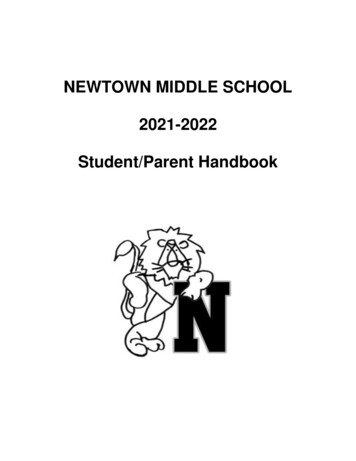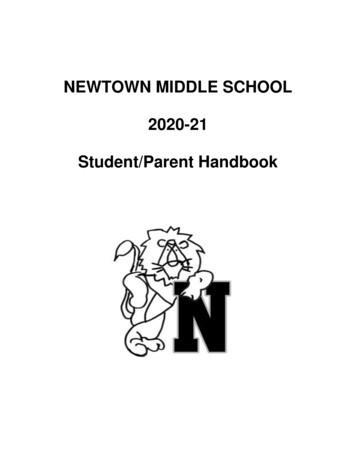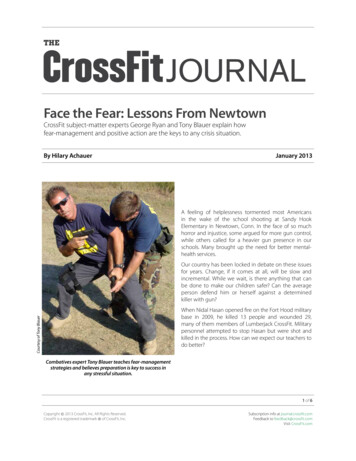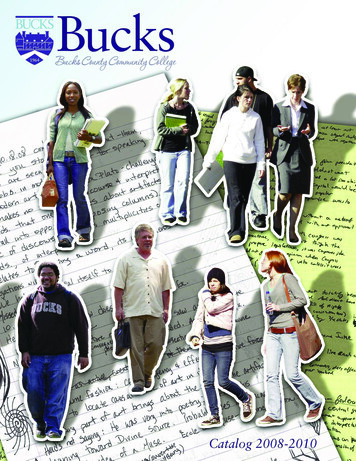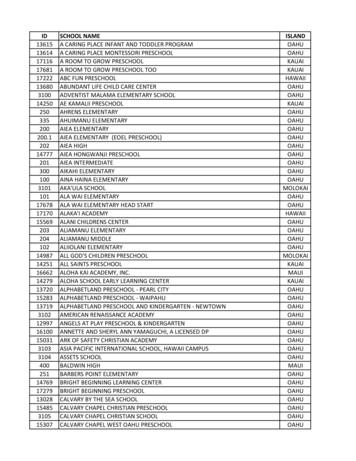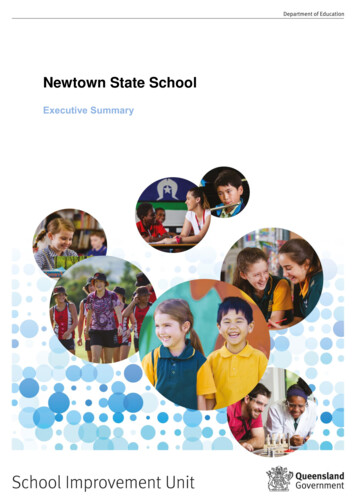
Transcription
Newtown State School
Contents1. Introduction . 31.1 Review team . 31.2 School context . 41.3 Contributing stakeholders . 51.4 Supporting documentary evidence. 52. Executive summary . 62.1 Key findings . 62.2 Key improvement strategies . 92
1. IntroductionThis report is a product of a review carried out by a review team from the SchoolImprovement Unit (SIU) at Newtown State School from 11 to 13 June 2019.The report presents an evaluation of the school’s performance against the nine domains ofthe National School Improvement Tool. It also recommends improvement strategies for theschool to implement in consultation with its regional office and school community.The report’s executive summary outlines key findings from the review and key improvementstrategies that prioritise future directions for improvement.Schools will publish the executive summary on the school website within two weeks ofreceiving the report.The principal will meet with their Assistant Regional Director (ARD) to discuss the reviewfindings and improvement strategies.For more information regarding the SIU and reviews for Queensland state schools pleasevisit the SIU website.1.1 Review teamMike EnnisInternal reviewer, SIU (review chair)Lisa MorrisonPeer reviewerPam HallExternal reviewer3
1.2 School contextLocation:Albert Street, NewtownEducation region:Darling Downs South West RegionYear opened:1924Year levels:Prep to Year 6Enrolment:398Indigenous enrolmentpercentage:27 per centStudents with disabilityenrolment percentage:7 per centIndex of Community SocioEducational Advantage(ICSEA) value:904Year principal appointed:2017Day 8 teacher full-timeequivalent (FTE):21.3Significant partner schools:All schools in the Southern Vale ClusterSignificant communitypartnerships:Toowoomba Base Hospital, Carbal MedicalServices, Essilor Vision Foundation, Lifeline,Bupa Optical & Hearing, United CareCommunity, Newtown Playgroup, The SmithFamily, City Women Bella Girls Program andthe Men of the City Boys Program.Significant school programs:Learning Sprints, Comprehension, Accuracy,Fluency and Expand (CAFÉ) Reading,Trauma Informed Practice4
1.3 Contributing stakeholdersThe following stakeholders contributed to the review:School community: Principal, deputy principal, Head of Student Support Services (HoSSS), guidanceofficer, pedagogy coach, teacher librarian/Positive Behaviour for Learning (PBL)coach, Business Manager (BM), chaplain, 23 teachers, 20 non-teaching staff, threeParents and Citizens’ Association (P&C) executive and members, 17 parents and 45students.Partner schools and other educational providers: Transition Officer Kulila Kindergarten Association, director Newtown Outside SchoolHours Care (OSHC), principal Wilsonton State High School and principal HarristownState High School.Government and departmental representatives: Coordinator Child Development Service Toowoomba Hospital, Deputy Mayor ofToowoomba, State Member for Toowoomba and ARD.1.4 Supporting documentary evidence5Annual Implementation Plan 2019P&C Strategic Plan 2018- 2021Investing for Success 2019Strategic Plan 2016-2019Headline Indicators (April 2019 release)School Data Profile (Semester 1 2019)OneSchoolSchool budget overviewProfessional learning plan 2019Curriculum planning documentsSchool improvement targetsSchool Support and ICP flowchartSchool pedagogical frameworkAnnual Professional Development PlansSchool Data Plan 2019School newsletters and websiteSchool Opinion SurveyResponsible Behaviour Plan for StudentsSchool based curriculum, assessmentand reporting frameworkParent and Community Engagementframework
2. Executive summary2.1 Key findingsSchool leaders have developed a number of key documents outlining schoolimprovement priorities.The priorities for 2019 are ‘all students will make progress in their ability to read’ and‘positively engage all students’, and are supported by a range of strategies, targets, timelinesand an identified responsible officer. All staff can identify the key priorities and targets andare supportive of the school direction. Parents interviewed are able to identify that the schoolfocuses on student attendance, behaviour and reading. Parents identify the consistentpromotion of these priority areas through school newsletters and parades.The pedagogy coach and deputy principal meet with year level teaching teams todiscuss student data as part of the ‘Learning Sprints’1 .The Learning Sprints are informed by analysis of the school reading data boards for allstudents in each year level that identify students’ performance. Many teachers state that thedata analysis and professional discussions in Learning Sprint meetings have enabled themto establish starting points for student learning, identify effective strategies, monitor studentgain and reflect on future learnings. Significant school resourcing underpins theimplementation of the Learning Sprints.The school places a high priority on student wellbeing, positive engagement andlearning.Staff members have established a range of processes and programs to support students’academic and wellbeing outcomes. Most parents, students and teachers describe therelationship between members of the school community as positive and respectful. Theculture of the school inspires staff members to exhibit high levels of professional energy forthe work they do. Staff members articulate great pride in the school and go the extra mile tosupport their colleagues and students.The leadership and teaching team express a commitment to implementing curriculumrelating to learning areas aligned to the Australian Curriculum (AC).The school leadership team and year level teacher teams guide the implementation of theEnglish and mathematics curriculum areas. These teams have developed a whole-schoolcurriculum plan to guide their work in the school and meet to review progress and plan futureactions. The leadership team has plans to finalise the implementation of all eight AC learningareas in 2020.1Breakspear, Simon. (2018). Learning sprints. Retrieved from http://simonbreakspear.com/learningsprints/6
Data is used to monitor progress against the school priorities.The school ‘Data Plan – Assessment and Reporting 2019’ includes diagnostic, formative andsummative assessments, timelines, and guidelines for undertaking assessments andreporting. Teachers have a range of understanding regarding the data plan and assessmenttools. Leadership team members are committed to continuing to develop teacher capacity toanalyse and reflect on their teaching practices using data.The leadership team and school staff are driving improvements in pedagogy, with astrong belief that improvements in teaching lead to improvements in student learning.The leadership team has high expectations for teachers to deliver effective pedagogicalpractices. They have collaboratively developed a pedagogical framework based on ExplicitInstruction (EI)2 incorporating the Gradual Release of Responsibility (GRR) Model3. Theframework aims to provide teachers with a guide to support their curriculum planningprocesses. Teachers report varying levels of understanding and application of thisframework in their classroom teaching.A whole-school curriculum plan is developed and describes expectations for teachingand learning at the school.Plans in most of the learning areas of the AC make clear the scope and sequence across allyears of schooling. After full implementation of all eight learning areas, the leadership teamrecognises that the next step in curriculum alignment to the AC is to focus on the crosscurriculum priorities and general capabilities.The school has an endorsed collegial engagement framework.Teachers have the opportunity to engage in observation and feedback with peers ormembers of the leadership team. This process focuses on the school improvement priorities,the enactment of the curriculum and signature pedagogical practices. Most teachers indicatetheir support of this process as it is beneficial to their capability development. Many staffnote the scheduled observation and feedback sessions are yet to occur on a regular basis.Positive Behaviour for Learning (PBL) is embedded across the school.Staff members support the school PBL framework and are able to clearly articulate PBLlanguage, strategies and processes. The leadership team and staff acknowledge and valuethe range of cultural, economic and social backgrounds of students and work together tosupport all students in a positive environment. Some PBL support programs are written intohealth units from Years 1 to 6. Students speak positively of the impact of the program onbehaviour. Communication of PBL to parents is well received.23Archer, A. L. (2014). Golden principles of explicit instruction [DVD]. New York, NY: Guilford Press.Fisher, D., & Frey, N. (2013). Better learning through structured teaching: A framework for thegradual release of responsibility. Alexandria, VA: Association for Supervision & CurriculumDevelopment (ASCD)7
The school values the significant support provided through the expertise of teacheraides.Teacher aides are trained in the school intervention programs and processes. Teacher aideswork alongside teachers in all classrooms supporting students’ learning and wellbeing.Additional ‘agile’ teacher aides are deployed to work on targeted reading intervention withsmall groups of students or one-to-one student support allowing them to respond toemergent needs.The principal and school staff have established an extensive range of partnerships.School staff have actively explored ways to support students’ academic progress andwellbeing through strategic partnerships that provide resources not available within theschool. The Parents and Citizens’ Association (P&C) is active and committed to the school.Some parents have a multigenerational connection to the school. A documented Parent andCommunity Engagement Framework (PaCE) lists the groups, organisations, events andactivities that strengthen the learning outcomes for students through effective partnerships.8
2.2 Key improvement strategiesBuild all teachers knowledge of the AC by further unpacking year level content descriptorsand standards, and fully implement all eight learning areas by the end of 2020.Build all teachers’ capacity in data literacy to increase ownership of class data.Establish school procedures to ensure teacher practice in all classrooms is closely aligned tothe school pedagogical framework.Develop the whole-school curriculum plan to include the AC cross-curriculum priorities andgeneral capabilities.Fully implement the school collegial engagement framework to quality assure the curriculumand signature pedagogical practices in all classrooms.9
Improvement Unit (SIU) at Newtown State School from 11 to 13 June 2019. . curriculum plan to guide their work in the school and meet to review progress and plan future actions. The leadership team has plans to finalise the implementation of all eight AC learning . Instruction (EI)2 incorporating the Gradual Release of Responsibility (GRR .
